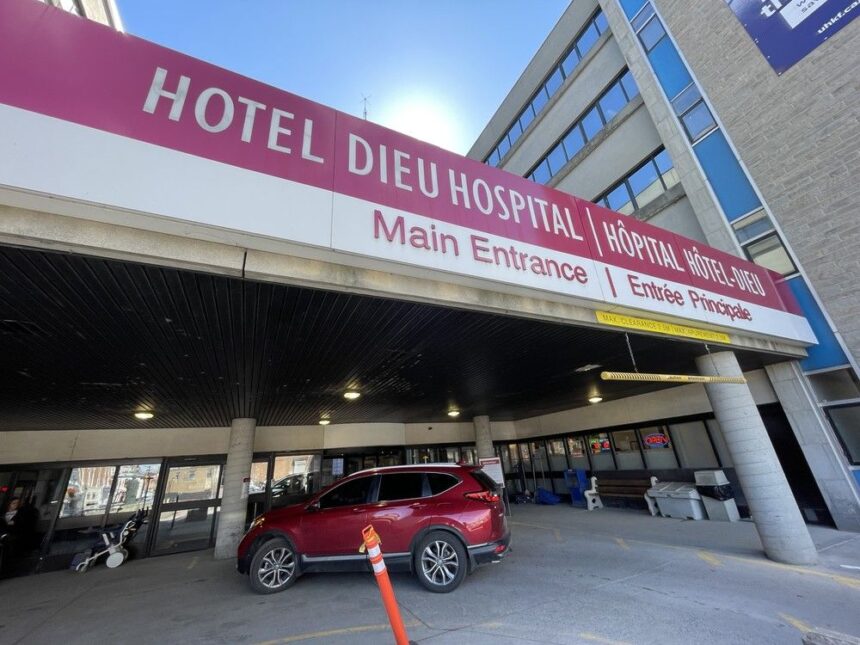I stepped onto the muddy field last Tuesday morning as light rain misted over what locals still call “the prison farm lands.” The sprawling 166-acre property along King Street West is eerily quiet now, but the site bustles with a different kind of energy as surveyors and planners move about with clipboards and measuring equipment. This expansive plot will soon become home to Kingston’s ambitious new hospital complex – a $2 billion transformation promising to reshape healthcare delivery for southeastern Ontario.
“We’ve outgrown our current facilities,” explains Dr. Renate Ilse, integration vice-president at Kingston Health Sciences Centre (KHSC), as we walk the perimeter of what will become the city’s largest infrastructure project in decades. “Some of our buildings date back to the 1830s. Medicine has changed dramatically since then, but our physical space hasn’t kept pace.”
The announcement ends years of speculation about the future of healthcare in the region. The new complex will consolidate services currently split between Kingston General Hospital (KGH) and Hotel Dieu Hospital, creating what officials describe as a “healthcare campus” that will serve over half a million residents across southeastern Ontario.
Kingston has long functioned as the healthcare hub for communities stretching from Trenton to Brockville and as far north as Bancroft. The region’s aging population and growing medical needs have strained existing facilities beyond capacity. Wait times at KGH’s emergency department routinely stretch beyond provincial targets, while patients in outlying communities often face lengthy travels for specialized care.
“My mother needed cardiac care last year,” recalls Belleville resident Janice Moretti, who I meet at a community information session about the project. “The ambulance bypassed our local hospital completely and drove straight to Kingston. That’s an hour away from our support system.” She sighs, then brightens slightly. “At least this new facility might make that experience better for the next family.”
The new complex will feature expanded emergency services, additional surgical suites, enhanced cancer care facilities, and integrated mental health services. Plans also include dedicated space for teaching and research, reinforcing Kingston’s role as a training ground for healthcare professionals through Queen’s University and St. Lawrence College.
What makes this project particularly distinctive is its integrated approach. Rather than simply building a replacement hospital, planners are designing a comprehensive health campus that will include supportive housing, rehabilitation facilities, outpatient clinics, and green spaces designed for healing.
“We’re thinking beyond just acute care,” says David Pichora, President and CEO of KHSC. “This is about creating environments that support wellness across the entire health journey.”
The project faces significant challenges. Construction costs have soared since initial estimates were developed pre-pandemic. The timeline stretches over a decade, with completion not expected until 2034. And the chosen location has sparked debate among Kingston residents concerned about transportation access and the loss of former agricultural lands.
“It’s too far from downtown,” argues Kingston resident and accessibility advocate Teresa Morrison. “Many vulnerable patients rely on public transit, which is already limited on the west end.” City officials counter that the master plan includes enhanced transit routes and multiple access points to accommodate various transportation needs.
Environmental considerations have also shaped the design process. The facility aims for LEED Gold certification with features like rainwater collection, solar arrays, and natural lighting throughout patient areas. Planners have committed to preserving much of the existing tree canopy and creating new green spaces accessible to patients, staff, and the surrounding community.
“Healthcare facilities are among the highest energy consumers in the public sector,” explains environmental engineer Sayra Cristancho, who’s consulting on the project. “This is an opportunity to demonstrate that healing environments can also be environmentally responsible.”
The economic impact extends beyond healthcare. The project is expected to create thousands of construction jobs and hundreds of permanent positions once operational. Local businesses anticipate increased activity, particularly in the city’s west end, which has seen slower development compared to other areas.
Community engagement sessions have revealed both excitement and concern among residents. Many celebrate the promise of expanded services and shorter wait times, while others worry about potential tax implications and changes to their neighborhoods.
For healthcare workers, the new facility represents a chance to work in environments designed around contemporary care models. “We’ve been adapting 19th-century spaces to deliver 21st-century medicine,” says KGH nurse Abigail Tenenbaum. “Imagine what we could do in spaces actually designed for modern healthcare.”
The Kingston project reflects a broader trend across Canada as communities grapple with aging healthcare infrastructure. According to the Canadian Institute for Health Information, nearly 40% of hospitals nationwide are over 50 years old, with many failing to meet current standards for infection control, privacy, and technological integration.
As I wrap up my visit, I notice a family standing at the edge of the property, pointing toward different areas as if imagining the future buildings. Their seven-year-old daughter asks her father, “Will my children be born in the new hospital?”
“Probably,” he answers, capturing both the lengthy timeline and the generational impact this project represents for Kingston and the surrounding communities it serves.
What stands today as open fields will, over the next decade, transform into a healthcare hub serving generations to come. The scale and complexity of the project reflect both the challenges and opportunities facing healthcare delivery in mid-sized Canadian communities – finding the balance between centralized expertise and accessible care, between cutting-edge facilities and sustainable operations, between immediate needs and future capacity.






